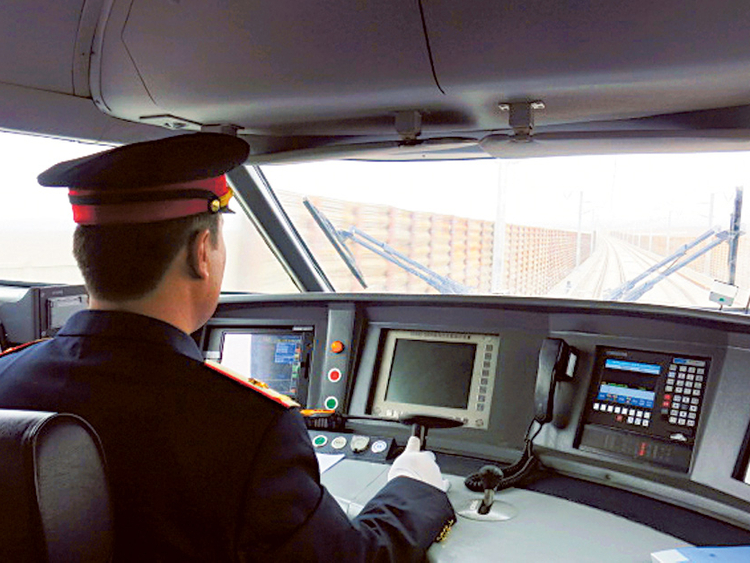
The brand-new bullet train slices past the edge of the Gobi desert, through gale-swept grasslands and past snowy peaks, a high-altitude, high-speed and high-tech manifestation of China’s newly re-imagined Silk Road meant to draw the country’s restive west ever tighter into Beijing’s embrace.
With growing determination, China is spreading its wings to the west, across its own, vast and resource-rich province of Xinjiang, and towards Central Asia and its huge reserves of oil and natural gas.
The $23 billion (Dh84.41 billion), high-speed train link, which is still being tested in winds that can sometimes reach up to 217 kilometres per hour, is just one symbol of that broader determination: to cement China’s control over its Muslim-majority Xinjiang region through investment and economic growth, secure important sources of energy and escape any risk of encirclement by American allies to the east.
The train will run from Lanzhou to Xinjiang’s capital, Urumqi; for the longer-term, China is even talking about trying to extend the high-speed network through Kyrgyzstan, Tajikistan, Uzbekistan, Turkmenistan, Iran and Turkey to Bulgaria.
“The high-speed railway will build the foundation for the Silk Road economic belt,” Erkin Tuniyaz, vice-chairman of the regional government, told reporters after a recent news media trip on the train. “Xinjiang will be the biggest beneficiary of the Silk Road. It will help it open up further, increase trade, tourism and other exchanges with neighboring countries. It’s a historical opportunity for Xinjiang.”
Indeed, as the United States enacts a strategic rebalance or “pivot” towards East Asia and withdraws troops from Afghanistan, China is responding with its own “pirouette” in the opposite direction, turning its face towards Central Asia and the West, says James Leibold, a regional specialist from Melbourne’s La Trobe University.
In a major speech on Xinjiang in May, President Xi Jinping vowed to promote ethnic unity and provide more jobs for local people. But at the same time, an intensified crackdown on conservative Islam has sparked resentment among many Muslim Uighurs.
Xinjiang is nearly as big as Alaska, its mountains and deserts hiding huge deposits of oil, natural gas, coal, gold and other minerals, but the province has just 22 million people. In 1949, when the Communist Party swept to power in China, Han Chinese made up less than 7 per cent of Xinjiang’s population; today, they comprise 40 per cent. Uighurs, at 43 per cent, are now a minority in the region, with other, mainly Muslim ethnic groups, making up the remaining 17 per cent of the province’s population.
Many Uighurs feel like second-class citizens in Xinjiang, culturally, socially and economically discriminated against by the now dominant Han. The capital, Urumqi, is a deeply divided city where the two groups barely mix and ethnic riots in 2009 left at least 200 people dead.
Nor has money helped. The opening up of the Chinese economy in the 1990s, coupled with significant investment in industry and infrastructure in Xinjiang, brought fast economic growth and higher living standards to the region, but those gains disproportionately benefited the Han people — and so fuelled more Uighur discontent.
Freed from strict government controls, state-owned enterprises run by Han managers overwhelmingly hired Han workers, often openly discriminating against Uighurs and attracting a new wave of Han migrants from what is known as “mainland China”.
Within the region, experts say the economic divide between the Han-majority northern city of Urumqi and the mainly Uighur, more rural south is both sharp and growing.
Implicitly acknowledging the existence of that divide, officials say the government is also hoping to promote a “southern Silk Road” that would pass through southern Xinjiang and revitalize ancient trading posts such as Kashgar and Hotan. Plans to establish textiles factories hold out the promise of jobs, while the eventual extension of the high-speed train on a new route to the south is supposed to promote what the Communist Party calls a more “modern” way of thinking.
“The building of the Silk Road, the south route, will help the ethnic groups become more open and modern,” said Lai Xin, a senior official at Xinjiang’s Development and Reform Commission, a key policy-making body. “As long as modern things enter Xinjiang, it will affect people’s way of living and production, and will change their way of thinking. We have to do something. We can’t leave them alone just because their way of thinking is backwards.”
Yet, as two Uighur scholars in Urumqi studied a map showing a new line for a high-speed passenger train, and the old railway line soon to be largely devoted to freight traffic, they could not escape a wry conclusion. “The resources from Xinjiang are going one way, and people from the mainland are coming the other way,” one said to the other.
Restrictions on the ability of Uighurs even to get passports, as well as the way the Han Chinese have so far monopolised the fruits of development in Xinjiang, do not bode well.
“If done well, the Silk Road could have a huge impact on Xinjiang and bring real development momentum,” said one of those scholars, speaking on the condition of anonymity because he was not authorised to comment to journalists and was fearful of inviting punishment.
“But it is doubtful how much benefit the Uighur people will get,” he said. “We need good policies, otherwise it will cause the divide between ethnic groups to widen even further — and that would be a disaster.”
–Washington Post













